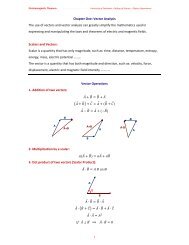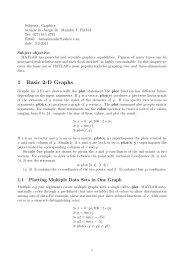Main types of chromite deposits:
Main types of chromite deposits:
Main types of chromite deposits:
You also want an ePaper? Increase the reach of your titles
YUMPU automatically turns print PDFs into web optimized ePapers that Google loves.
Magmatic Base metal <strong>deposits</strong>:<br />
These deposit <strong>types</strong> include:<br />
1- Chromite <strong>deposits</strong><br />
2- Nickel – Copper <strong>deposits</strong><br />
3- Platinum group metal (PGM) <strong>deposits</strong><br />
1-Chromite <strong>deposits</strong><br />
Are the end product <strong>of</strong> the separation <strong>of</strong> solid phase (Cr-rich)<br />
spinel, (Fe,Mg)(Al,Cr,Fe) 2 O 4 from a liquid and their<br />
accumulation in to <strong>chromite</strong>-rich layer.<br />
<strong>Main</strong> <strong>types</strong> <strong>of</strong> <strong>chromite</strong> <strong>deposits</strong>:
A- Stratiform <strong>chromite</strong> <strong>deposits</strong>:<br />
Consist <strong>of</strong> laterally persist <strong>chromite</strong> rich layer a few (mm) to<br />
several (m) thick alternating with silicate layer.<br />
• The silicate layer include ultramafic and mafic rock such<br />
as dunite, peridotite, pyroxenite and variety <strong>of</strong> others, less<br />
commonly gabbroic rocks they are generally found within<br />
basal portions <strong>of</strong> mafic –ultramafic layered intrusions <strong>of</strong><br />
Archean age such as the Bushveld igneous complex in<br />
south Africa and Canadian stratiform <strong>chromite</strong> <strong>deposits</strong>.<br />
The (average Cr 2 O 3 = 10.7 %)<br />
• Each <strong>chromite</strong> band occupies a stratigraphic position the<br />
layer are not deformed composed <strong>of</strong> small euhedral<br />
<strong>chromite</strong> crystals and do not exhibited nodular or orbicular<br />
texture.
B- Podiform <strong>chromite</strong> <strong>deposits</strong>:<br />
• Consist <strong>of</strong> pod to pencil-like, irregularly shaped massive<br />
<strong>chromite</strong> bodies and they are predominantly found within<br />
dunitic (olivine-rich) portions <strong>of</strong> Ophiolite Complexes.<br />
The rock associated with podiform <strong>chromite</strong> is generally referred<br />
to as Alpine-type peridotites and they are usually found along<br />
major fault zones within mountain belt.<br />
The <strong>chromite</strong> may exhibit nodular texture and show deformation<br />
structure such as pull- apart textures.<br />
• Crystal grains are generally variable in size
Chromite pods envelops by dunite and separated from the<br />
adjacent pot by harzbergite
Structure classification <strong>of</strong> <strong>chromite</strong> pods:<br />
1- Concordant <strong>deposits</strong>:<br />
This type makes up about 50 percent <strong>of</strong> the <strong>chromite</strong> occurrences<br />
1- Most are tabular in shape but rarely may they have a pencil<br />
form.<br />
2- When such a <strong>deposits</strong> consist <strong>of</strong> several sheets, these sheet<br />
or plate have a dunite wall and are always from each other by<br />
harzburgite.<br />
3- Three type <strong>deposits</strong> contain massive, disseminated and<br />
antinodular ores; massive ore have always pull-apart textures.<br />
4- The ore lenses and its internal foliation and lineation are<br />
parallel to those in the host rock peridotite<br />
5- Such ore bodies have internal structure make angle <strong>of</strong> 20<br />
with dunite wall and surrounding peridotite.
2- Sub concordant <strong>deposits</strong>:<br />
This type makes up about 25 % <strong>of</strong> the <strong>chromite</strong> occurrences.<br />
1- Such ore bodies have internal structure make angle <strong>of</strong> 20<br />
with dunite wall and surrounding peridotite<br />
2- Lineation within the ore can be follow local change in the dip<br />
<strong>of</strong> ore sheet.<br />
3- These <strong>deposits</strong> are typically tabular in form.<br />
4- Ores are much less deformed and pull a part texture in the<br />
massive ore are rarely and poorly exposed.<br />
5- They are characterized by very large olivine grains and <strong>of</strong>ten<br />
contain large equine <strong>chromite</strong> crystal > 1 cm.<br />
6- A zone rich in dunite patches appears to run either slightly or<br />
strongly oblique to harzburgite
3- Discordant <strong>deposits</strong>:<br />
1- This type deposit <strong>of</strong> <strong>chromite</strong> represents about 25 % <strong>of</strong><br />
<strong>chromite</strong> occurrences<br />
2- The main feature <strong>of</strong> this class <strong>of</strong> <strong>deposits</strong> may be<br />
summarized as follows;<br />
3- Structure in the rocks immediately surrounding the deposit is<br />
disturbed with respect to their regional latitude.<br />
4- Lineation in the ore is not always present because the ore is<br />
sometimes only slightly deformed.<br />
5- Lineation in the surrounding peridotite give the general<br />
direction <strong>of</strong> extension <strong>of</strong> the ore body.<br />
6- This type have also massive, disseminated, antinodular, and<br />
banded ores, the last type show sedimentary feature such as<br />
slump and cross bedding.
Exploration (prospecting) Guidelines <strong>of</strong> <strong>chromite</strong><br />
<strong>deposits</strong>.<br />
• Stratiform <strong>chromite</strong> <strong>deposits</strong>:<br />
1- Identify well layered mafic – ultramafic<br />
intrusions.<br />
2- Prospect below the mafic cumulate portions <strong>of</strong><br />
intrusions (below the portion which is<br />
completely gabbroic).<br />
• Podiform <strong>chromite</strong> <strong>deposits</strong>:<br />
a- Carefully prospect within all dnitic portion <strong>of</strong><br />
Alpine- type peridotite (Harzburgite -dunite<br />
component <strong>of</strong> Ophiolite Complexes).
• Origin <strong>of</strong> <strong>chromite</strong> <strong>deposits</strong>:<br />
• All <strong>chromite</strong> <strong>deposits</strong> are believed to have formed<br />
by early crystal settling or by late gravitative liquid<br />
accumulation. These processes aid in<br />
understanding how layered <strong>deposits</strong> form, but<br />
where differential pressures exist, liquid injection<br />
is more likely to form podiform <strong>deposits</strong>.<br />
• Kind <strong>of</strong> <strong>deposits</strong><br />
• Almost all <strong>chromite</strong> <strong>deposits</strong> are magmatic<br />
segregation in ultrabasic rocks. Chromite occurs<br />
in the host rock as masses, lenses, and<br />
dissemination.
• Mineralogy, Tenor, and Treatment<br />
• Mineralogy, and Tenor<br />
• There is only one mineral, <strong>chromite</strong>, that<br />
theoretically carries 68 % Cr 2 O 3 and 32 %<br />
FeO, but Al 2 O 3 , Fe 2 O 3 , MgO, CaO and SiO 2<br />
may displace some Cr 2 O 3 , reducing the Cr 2 O 3<br />
content to as little as 40 % Chromite<br />
chemically varies within wide limits permitted<br />
by formula (Mg, Fe +2 ) (Cr, Al, Fe +3 ) 2 O 4 .<br />
Commercial ores should contain 45 % Cr 2 O 3 .<br />
The chrome-iron ratio should be above 2.5:1<br />
for metallurgical chrome.
• Treatments:<br />
• Chromite is marked as lump <strong>chromite</strong> after<br />
hand sorting or rough concentration. Most<br />
<strong>chromite</strong> ores are not adaptable to<br />
concentration processes.<br />
• The chrome ore is smelted in an electric<br />
furnace with fluxes and carbon to<br />
ferrochrome, in which form most <strong>of</strong> its<br />
marked.
• Uses:<br />
• The main uses for chromium are: metallurgical,<br />
67%; refractories, 18 %; and chemical, 15 %. The<br />
metallurgical uses include a great variety <strong>of</strong> alloys,<br />
mainly with iron, nickel, and cobalt.<br />
• Chromium impart to alloys strength, toughness,<br />
hardness, and resistance to oxidation, corrosion,<br />
abrasion, chemical attack, electrical conductivity<br />
and high temperature breakdown.<br />
• The great strength <strong>of</strong> chrome steels allows a<br />
reduction in the weight <strong>of</strong> metal in automobile,<br />
airplane and trains. The stainless steels containing<br />
18% Cr and 8 % Ni.
A<br />
B<br />
Brecciated chromitite rocks, the <strong>chromite</strong> grain transected by many cracks. (A: under<br />
PPL, B: XP).
A<br />
B<br />
Disseminated subhedral to anhedral <strong>chromite</strong> crystal in a matrix <strong>of</strong> olivine<br />
in north <strong>of</strong> Kuradawi village (A: under PPL, B: XP).
A<br />
B<br />
Anhedral crystals <strong>of</strong> <strong>chromite</strong> showing pull-a part texture and most <strong>of</strong><br />
<strong>chromite</strong> grains exhibit thin rims <strong>of</strong> ferrit<strong>chromite</strong>, the white interstitial<br />
represents the matrix. (A: under PPL. B: under XP).

















